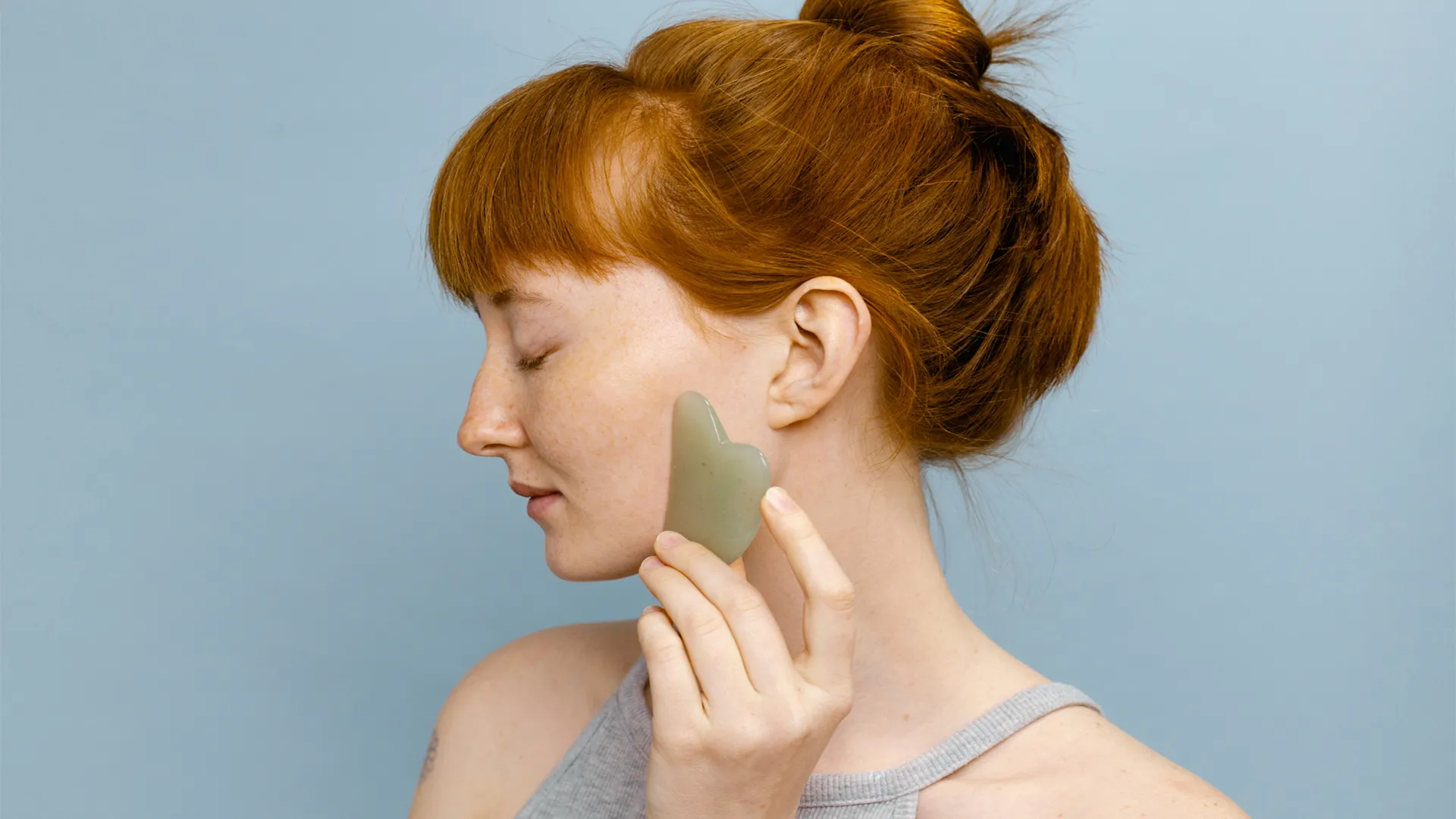Face yoga exercises the face muscles while gua sha relaxes them and increases circulation. When done together, they can reduce fine lines, puffiness, and even migraines. Learn more about the role these two complementary wellness habits can play in your self-care routine.
Don’t write off face yoga and gua sha as mere beauty fads. These practices have positive impacts on your skin and muscle tone, and if done consistently, they will pay off in how you feel and look as you grow older.
Face yoga consists of facial exercises that stretch and exercise muscles in the face and neck. (If you’ve done yoga, think Lion's Breath — constricting the face and then exhaling with the tongue fully exposed — as one example of a face yoga exercise.)
Gua sha is an ancient Chinese healing practice that massages the face and neck, among other parts of the body, typically with the aid of a tool, such as a curved stone or a roller, to stimulate circulation to the skin.
Both gua sha and face yoga offer unique benefits. When practiced together, they provide a natural and impactful way to help your skin age gracefully.
“[Face] yoga trains the muscles to make a face more toned and well formed, [and] gua sha helps to relax it,” explains Dr. Rosmy Barrios, MD, a medical advisor for Health Reporter and a regenerative medicine specialist.
“The difference is that gua sha stimulates microcirculation in the face and is a great practice to immediately reduce facial swelling and puffiness,” says Dr. Barrios.
Face yoga, on the other hand, is for long-term toning benefits.
The Science Behind Face Yoga and Gua Sha
As we age, the skin loses elasticity. This is what essentially “holds up” the fat and muscles in the face, and our bodies as a whole. If we want to combat premature aging, it’s important to regularly strengthen the muscles of the face as we age, just as we would the rest of the body.
“The muscles of the face respond to exercise just as the muscles in the body. They like to be stretched,” explains Annelise Hagen, author of The Yoga Face: Eliminate Wrinkles with the Ultimate Natural Face Lift, as well as a gua sha stone designer and face-yoga training instructor. The expert, whom DailyOM spoke with for this article, says, “The face muscles respond to exercise that brings in oxygen and blood flow, and just like weightlifting for other muscles, [face yoga] helps tone the face.”
While yoga has been practiced for centuries, the practice of face yoga on its own is relatively new. However, Northwestern University recently confirmed its effectiveness with a study testing how facial exercises could affect facial appearance. The researchers had women ages 40–65 do facial exercises for 30 minutes each day, engaging in a series of 32 various facial exercises for one minute each, over the course of 20 weeks.
The results are encouraging, to say the least. The researchers reported that the “facial exercise” participants showed a three-year decrease in age appearance after those 20 weeks, based on dermatologists’ assessment of their photos using a standardized facial aging scale.
“Now there is some evidence that facial exercises may improve facial appearance and reduce some visible signs of aging,” said lead author Dr. Murad Alam, vice chair and professor of dermatology at Northwestern University Feinberg School of Medicine and a Northwestern Medicine dermatologist, in the study’s press release. “The exercises enlarge and strengthen the facial muscles, so the face becomes firmer and more toned and shaped like a younger face.”
Research has also validated gua sha’s impact, from both an aesthetic angle and for overall wellness.
One study found that gua sha increased microcirculation to the skin by 400 percent and lasted 25 minutes following the treatment. According to Barrios, increased microcirculation contributes to skin toning, rejuvenation, and reduction of wrinkles.
Another study found that gua sha massage triggered increased antioxidant protection in multiple internal organs in mice immediately after and even for days following the gua sha treatment, as observed with bioluminescent imaging. There is also research that supports gua sha as a treatment for migraines, neck pain, back pain, and breast mastitis (an infection in the breast, most common in women who are breastfeeding).
Interested in learning more? Check out Anti-Aging Face Yoga
How to Start Face Yoga and Gua Sha
Thirty minutes a day of facial exercises was the magic number for researchers, but Hagen notes that even a small amount of face yoga or gua sha (think five minutes of face yoga followed by five minutes of gua sha) could make a noticeable difference. And it’s never too late to add this routine to your day.
“Gua sha picks up where face yoga leaves off. It’s like going to a dance class and then getting a massage afterward.”
“You can start [face yoga or gua sha] at any point,” says Hagen to DailyOM. “As long as you have muscles, you will get benefits from [these] exercises.”
For gua sha, you may wish to experiment with various stones designed for specific areas of the face or neck. The gua sha stones with bigger “teeth” will help break up fascia — the connective tissue made up mostly of collagen that can bring about deep-set wrinkles. A stone with a “scoop” is ideal for contouring and getting rid of any scars or adhesions. It also can help with lymphatic drainage, which helps remove waste and toxins from body tissues when used at the hairline, under the ears, and above the collar bone, Hagen explains to DailyOM.
Meanwhile a gua sha roller is great for treating puffy eyes, or you can use your fingers around this delicate area. For example, you can lightly pinch the skin above and below your eyebrows (as though you’re crimping a pie crust), which will help lift them.
Face Yoga Versus Gua Sha: Which One Is Better?
The verdict: Both are great! Ideally, face yoga and gua sha should be done in tandem to maximize each one’s benefits.
“For me, [gua sha] picks up where face yoga leaves off,” Hagen describes to DailyOM. “It’s like going to a dance class and then getting a massage afterward.”
Barrios adds that while both are beneficial, you will likely see faster results from gua sha due to the increased circulation of the skin. Face yoga will also pay off, but it will require more time and patience. And face yoga is a promising alternative to Botox since it is painless and less expensive, and won’t result in uneven facial expressions, the expert adds.
The truth is that you might not see an immediate change when you first try face yoga and gua sha. And that’s okay. Most beauty practices worth keeping require patience.
Rather than focusing entirely on whatever physical changes you want face yoga or gua sha to make happen, consider how these rituals could elevate your self-care. What if they could help you have a more positive, loving relationship with your skin? Or help you feel uplifted and at your best for those early morning meetings? Or serve as a soothing nighttime wind-down, especially if you might struggle with migraines or neck pain that gua sha can help treat?
All of these are wonderful reasons to bring these two beauty practices into your daily self-care routine. And when you feel your best, that’s when your true beauty shines through.

